2007 ISUZU KB P190 sensor
[x] Cancel search: sensorPage 1165 of 6020
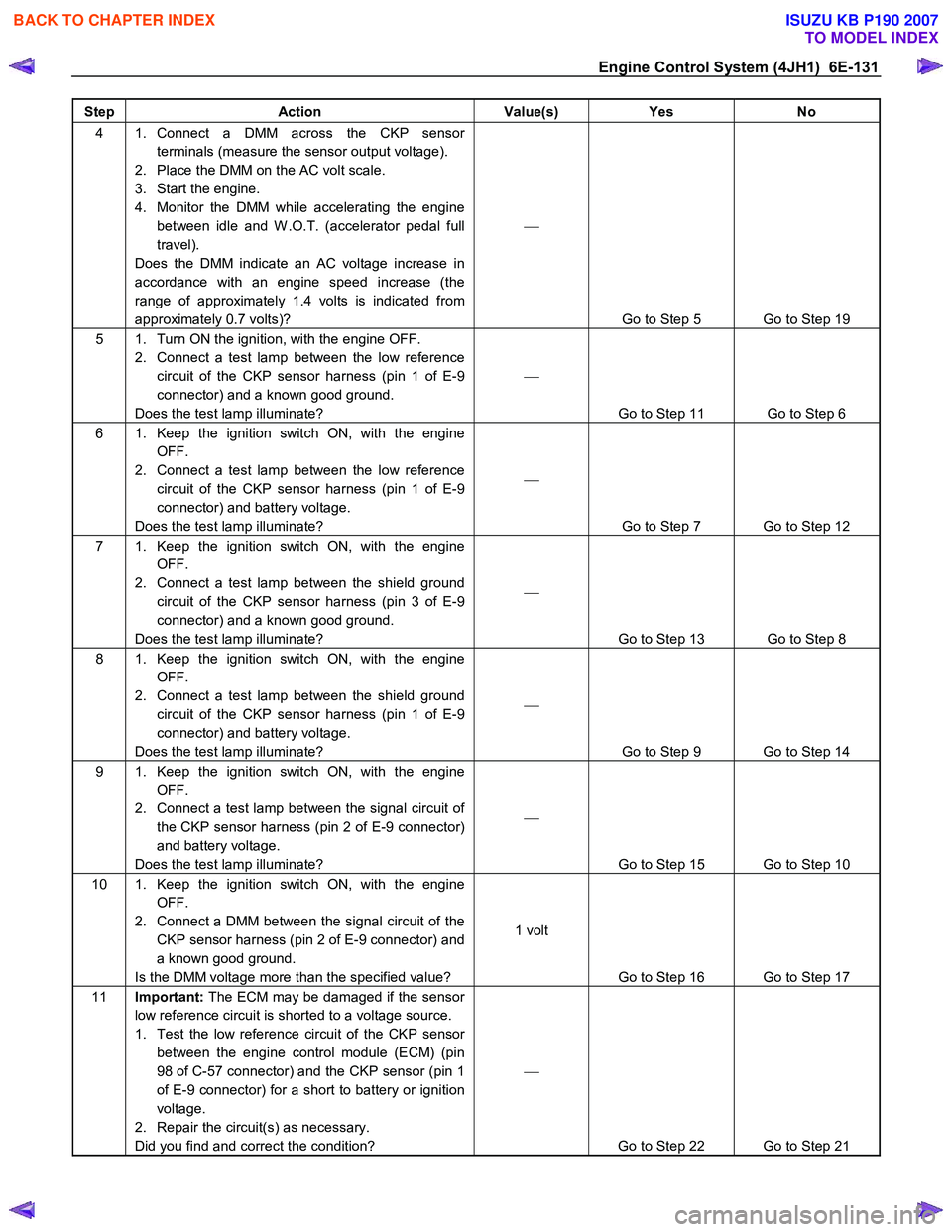
Engine Control System (4JH1) 6E-131
Step Action Value(s) Yes No
4 1. Connect a DMM across the CKP sensor
terminals (measure the sensor output voltage).
2. Place the DMM on the AC volt scale.
3. Start the engine.
4. Monitor the DMM while accelerating the engine between idle and W .O.T. (accelerator pedal full
travel).
Does the DMM indicate an AC voltage increase in
accordance with an engine speed increase (the
range of approximately 1.4 volts is indicated from
approximately 0.7 volts)?
Go to Step 5 Go to Step 19
5 1. Turn ON the ignition, with the engine OFF. 2. Connect a test lamp between the low reference circuit of the CKP sensor harness (pin 1 of E-9
connector) and a known good ground.
Does the test lamp illuminate?
Go to Step 11 Go to Step 6
6 1. Keep the ignition switch ON, with the engine OFF.
2. Connect a test lamp between the low reference circuit of the CKP sensor harness (pin 1 of E-9
connector) and battery voltage.
Does the test lamp illuminate?
Go to Step 7 Go to Step 12
7 1. Keep the ignition switch ON, with the engine OFF.
2. Connect a test lamp between the shield ground circuit of the CKP sensor harness (pin 3 of E-9
connector) and a known good ground.
Does the test lamp illuminate?
Go to Step 13 Go to Step 8
8 1. Keep the ignition switch ON, with the engine OFF.
2. Connect a test lamp between the shield ground circuit of the CKP sensor harness (pin 1 of E-9
connector) and battery voltage.
Does the test lamp illuminate?
Go to Step 9 Go to Step 14
9 1. Keep the ignition switch ON, with the engine OFF.
2. Connect a test lamp between the signal circuit of the CKP sensor harness (pin 2 of E-9 connector)
and battery voltage.
Does the test lamp illuminate?
Go to Step 15 Go to Step 10
10 1. Keep the ignition switch ON, with the engine OFF.
2. Connect a DMM between the signal circuit of the CKP sensor harness (pin 2 of E-9 connector) and
a known good ground.
Is the DMM voltage more than the specified value? 1 volt
Go to Step 16 Go to Step 17
11 Important: The ECM may be damaged if the sensor
low reference circuit is shorted to a voltage source.
1. Test the low reference circuit of the CKP sensor between the engine control module (ECM) (pin
98 of C-57 connector) and the CKP sensor (pin 1
of E-9 connector) for a short to battery or ignition
voltage.
2. Repair the circuit(s) as necessary.
Did you find and correct the condition?
Go to Step 22 Go to Step 21
BACK TO CHAPTER INDEX
TO MODEL INDEX
ISUZU KB P190 2007
Page 1166 of 6020
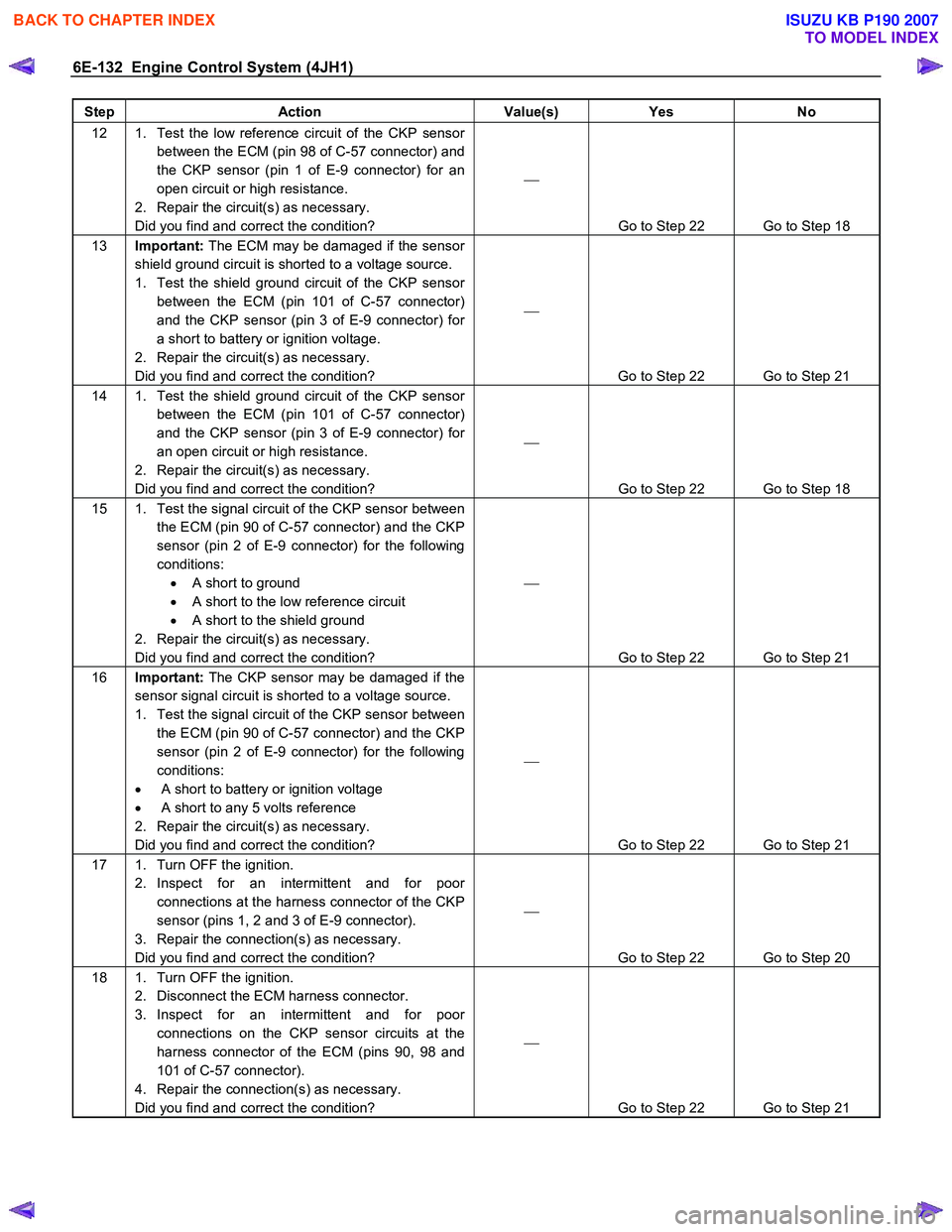
6E-132 Engine Control System (4JH1)
Step Action Value(s) Yes No
12 1. Test the low reference circuit of the CKP sensor
between the ECM (pin 98 of C-57 connector) and
the CKP sensor (pin 1 of E-9 connector) for an
open circuit or high resistance.
2. Repair the circuit(s) as necessary.
Did you find and correct the condition?
Go to Step 22 Go to Step 18
13 Important: The ECM may be damaged if the sensor
shield ground circuit is shorted to a voltage source.
1. Test the shield ground circuit of the CKP sensor between the ECM (pin 101 of C-57 connector)
and the CKP sensor (pin 3 of E-9 connector) for
a short to battery or ignition voltage.
2. Repair the circuit(s) as necessary.
Did you find and correct the condition?
Go to Step 22 Go to Step 21
14 1. Test the shield ground circuit of the CKP sensor between the ECM (pin 101 of C-57 connector)
and the CKP sensor (pin 3 of E-9 connector) for
an open circuit or high resistance.
2. Repair the circuit(s) as necessary.
Did you find and correct the condition?
Go to Step 22 Go to Step 18
15 1. Test the signal circuit of the CKP sensor between the ECM (pin 90 of C-57 connector) and the CKP
sensor (pin 2 of E-9 connector) for the following
conditions: • A short to ground
• A short to the low reference circuit
• A short to the shield ground
2. Repair the circuit(s) as necessary.
Did you find and correct the condition?
Go to Step 22 Go to Step 21
16 Important: The CKP sensor may be damaged if the
sensor signal circuit is shorted to a voltage source.
1. Test the signal circuit of the CKP sensor between the ECM (pin 90 of C-57 connector) and the CKP
sensor (pin 2 of E-9 connector) for the following
conditions:
• A short to battery or ignition voltage
• A short to any 5 volts reference
2. Repair the circuit(s) as necessary.
Did you find and correct the condition?
Go to Step 22 Go to Step 21
17 1. Turn OFF the ignition. 2. Inspect for an intermittent and for poor connections at the harness connector of the CKP
sensor (pins 1, 2 and 3 of E-9 connector).
3. Repair the connection(s) as necessary.
Did you find and correct the condition?
Go to Step 22 Go to Step 20
18 1. Turn OFF the ignition. 2. Disconnect the ECM harness connector.
3. Inspect for an intermittent and for poor connections on the CKP sensor circuits at the
harness connector of the ECM (pins 90, 98 and
101 of C-57 connector).
4. Repair the connection(s) as necessary.
Did you find and correct the condition?
Go to Step 22 Go to Step 21
BACK TO CHAPTER INDEX
TO MODEL INDEX
ISUZU KB P190 2007
Page 1167 of 6020
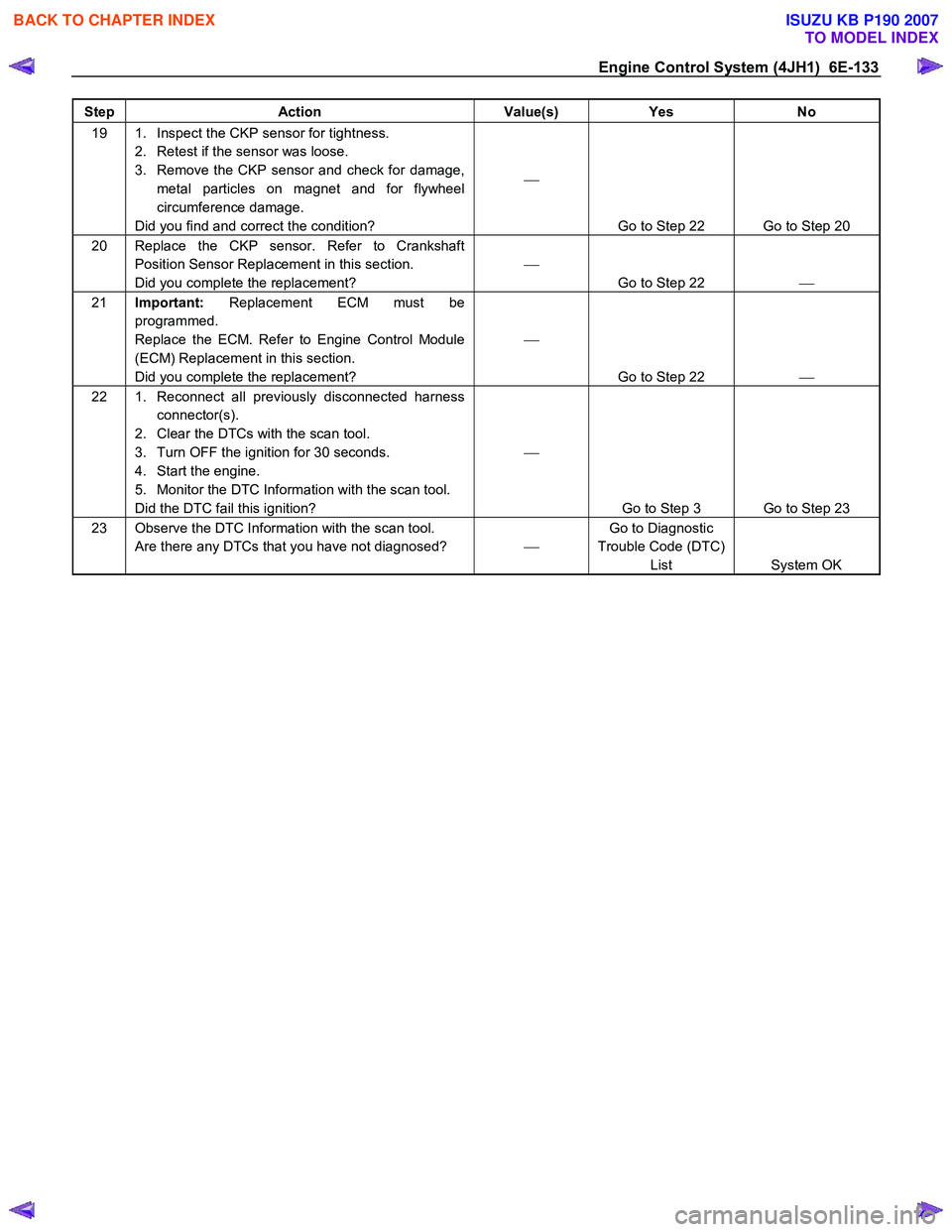
Engine Control System (4JH1) 6E-133
Step Action Value(s) Yes No
19 1. Inspect the CKP sensor for tightness.
2. Retest if the sensor was loose.
3. Remove the CKP sensor and check for damage, metal particles on magnet and for flywheel
circumference damage.
Did you find and correct the condition?
Go to Step 22 Go to Step 20
20 Replace the CKP sensor. Refer to Crankshaft Position Sensor Replacement in this section.
Did you complete the replacement?
Go to Step 22
21 Important: Replacement ECM must be
programmed.
Replace the ECM. Refer to Engine Control Module
(ECM) Replacement in this section.
Did you complete the replacement?
Go to Step 22
22 1. Reconnect all previously disconnected harness
connector(s).
2. Clear the DTCs with the scan tool.
3. Turn OFF the ignition for 30 seconds.
4. Start the engine.
5. Monitor the DTC Information with the scan tool.
Did the DTC fail this ignition?
Go to Step 3 Go to Step 23
23 Observe the DTC Information with the scan tool. Are there any DTCs that you have not diagnosed? Go to Diagnostic
Trouble Code (DTC) List System OK
BACK TO CHAPTER INDEX
TO MODEL INDEX
ISUZU KB P190 2007
Page 1168 of 6020
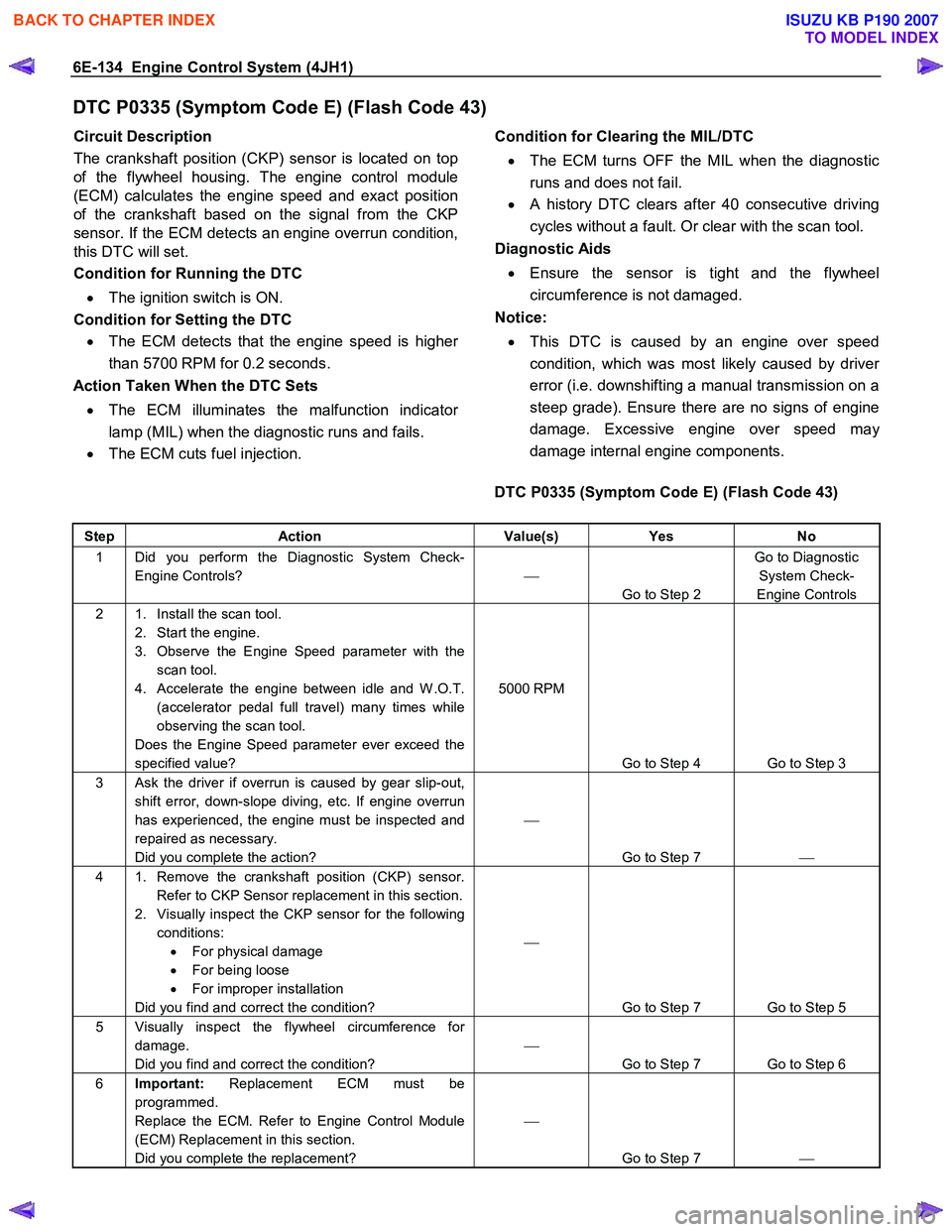
6E-134 Engine Control System (4JH1)
DTC P0335 (Symptom Code E) (Flash Code 43)
Circuit Description
The crankshaft position (CKP) sensor is located on top
of the flywheel housing. The engine control module
(ECM) calculates the engine speed and exact position
of the crankshaft based on the signal from the CKP
sensor. If the ECM detects an engine overrun condition,
this DTC will set.
Condition for Running the DTC
• The ignition switch is ON.
Condition for Setting the DTC • The ECM detects that the engine speed is highe
r
than 5700 RPM for 0.2 seconds.
Action Taken When the DTC Sets
• The ECM illuminates the malfunction indicato
r
lamp (MIL) when the diagnostic runs and fails.
• The ECM cuts fuel injection.
Condition for Clearing the MIL/DTC
• The ECM turns OFF the MIL when the diagnostic
runs and does not fail.
• A history DTC clears after 40 consecutive driving
cycles without a fault. Or clear with the scan tool.
Diagnostic Aids
• Ensure the sensor is tight and the flywheel
circumference is not damaged.
Notice:
• This DTC is caused by an engine over speed
condition, which was most likely caused by drive
r
error (i.e. downshifting a manual transmission on a
steep grade). Ensure there are no signs of engine
damage. Excessive engine over speed ma
y
damage internal engine components.
DTC P0335 (Symptom Code E) (Flash Code 43)
Step Action Value(s) Yes No
1 Did you perform the Diagnostic System Check-
Engine Controls?
Go to Step 2 Go to Diagnostic
System Check-
Engine Controls
2 1. Install the scan tool. 2. Start the engine.
3. Observe the Engine Speed parameter with the scan tool.
4. Accelerate the engine between idle and W .O.T. (accelerator pedal full travel) many times while
observing the scan tool.
Does the Engine Speed parameter ever exceed the
specified value? 5000 RPM
Go to Step 4 Go to Step 3
3 Ask the driver if overrun is caused by gear slip-out, shift error, down-slope diving, etc. If engine overrun
has experienced, the engine must be inspected and
repaired as necessary.
Did you complete the action?
Go to Step 7
4 1. Remove the crankshaft position (CKP) sensor.
Refer to CKP Sensor replacement in this section.
2. Visually inspect the CKP sensor for the following conditions: • For physical damage
• For being loose
• For improper installation
Did you find and correct the condition?
Go to Step 7 Go to Step 5
5 Visually inspect the flywheel circumference for damage.
Did you find and correct the condition?
Go to Step 7 Go to Step 6
6 Important: Replacement ECM must be
programmed.
Replace the ECM. Refer to Engine Control Module
(ECM) Replacement in this section.
Did you complete the replacement?
Go to Step 7
BACK TO CHAPTER INDEX
TO MODEL INDEX
ISUZU KB P190 2007
Page 1180 of 6020
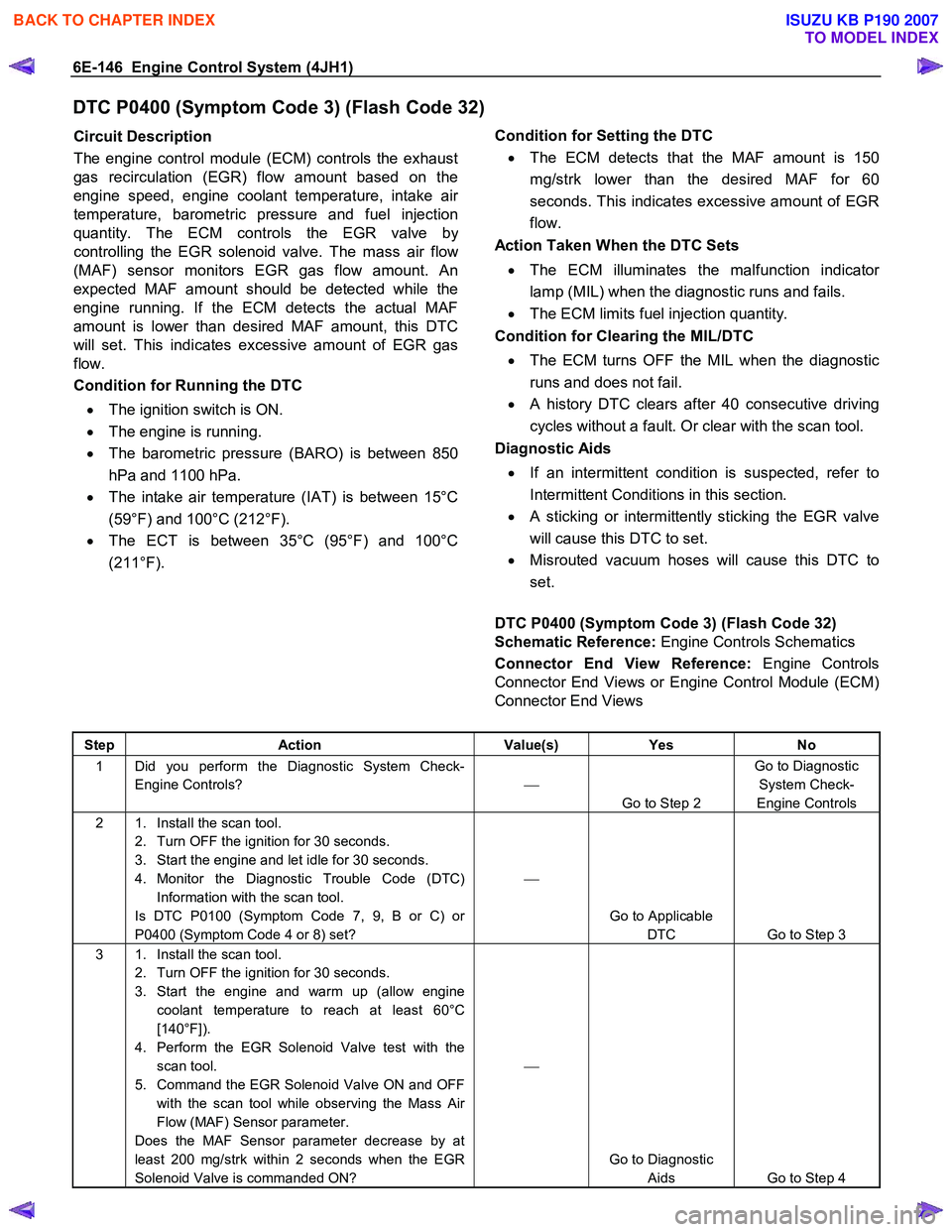
6E-146 Engine Control System (4JH1)
DTC P0400 (Symptom Code 3) (Flash Code 32)
Circuit Description
The engine control module (ECM) controls the exhaust
gas recirculation (EGR) flow amount based on the
engine speed, engine coolant temperature, intake ai
r
temperature, barometric pressure and fuel injection
quantity. The ECM controls the EGR valve b
y
controlling the EGR solenoid valve. The mass air flo
w
(MAF) sensor monitors EGR gas flow amount. An
expected MAF amount should be detected while the
engine running. If the ECM detects the actual MAF
amount is lower than desired MAF amount, this DTC
will set. This indicates excessive amount of EGR gas
flow.
Condition for Running the DTC
• The ignition switch is ON.
• The engine is running.
• The barometric pressure (BARO) is between 850
hPa and 1100 hPa.
• The intake air temperature (IAT) is between 15°C
(59°F) and 100°C (212°F).
• The ECT is between 35°C (95°F) and 100°C
(211°F).
Condition for Setting the DTC
• The ECM detects that the MAF amount is 150
mg/strk lower than the desired MAF for 60
seconds. This indicates excessive amount of EGR
flow.
Action Taken When the DTC Sets
• The ECM illuminates the malfunction indicator
lamp (MIL) when the diagnostic runs and fails.
• The ECM limits fuel injection quantity.
Condition for Clearing the MIL/DTC
• The ECM turns OFF the MIL when the diagnostic
runs and does not fail.
• A history DTC clears after 40 consecutive driving
cycles without a fault. Or clear with the scan tool.
Diagnostic Aids
• If an intermittent condition is suspected, refer to
Intermittent Conditions in this section.
• A sticking or intermittently sticking the EGR valve
will cause this DTC to set.
• Misrouted vacuum hoses will cause this DTC to
set.
DTC P0400 (Symptom Code 3) (Flash Code 32)
Schematic Reference: Engine Controls Schematics
Connector End View Reference: Engine Controls
Connector End Views or Engine Control Module (ECM)
Connector End Views
Step Action Value(s) Yes No
1 Did you perform the Diagnostic System Check-
Engine Controls?
Go to Step 2 Go to Diagnostic
System Check-
Engine Controls
2 1. Install the scan tool. 2. Turn OFF the ignition for 30 seconds.
3. Start the engine and let idle for 30 seconds.
4. Monitor the Diagnostic Trouble Code (DTC) Information with the scan tool.
Is DTC P0100 (Symptom Code 7, 9, B or C) or
P0400 (Symptom Code 4 or 8) set?
Go to Applicable DTC Go to Step 3
3 1. Install the scan tool. 2. Turn OFF the ignition for 30 seconds.
3. Start the engine and warm up (allow engine coolant temperature to reach at least 60°C
[140°F]).
4. Perform the EGR Solenoid Valve test with the scan tool.
5. Command the EGR Solenoid Valve ON and OFF with the scan tool while observing the Mass Air
Flow (MAF) Sensor parameter.
Does the MAF Sensor parameter decrease by at
least 200 mg/strk within 2 seconds when the EGR
Solenoid Valve is commanded ON?
Go to Diagnostic Aids Go to Step 4
BACK TO CHAPTER INDEX
TO MODEL INDEX
ISUZU KB P190 2007
Page 1181 of 6020
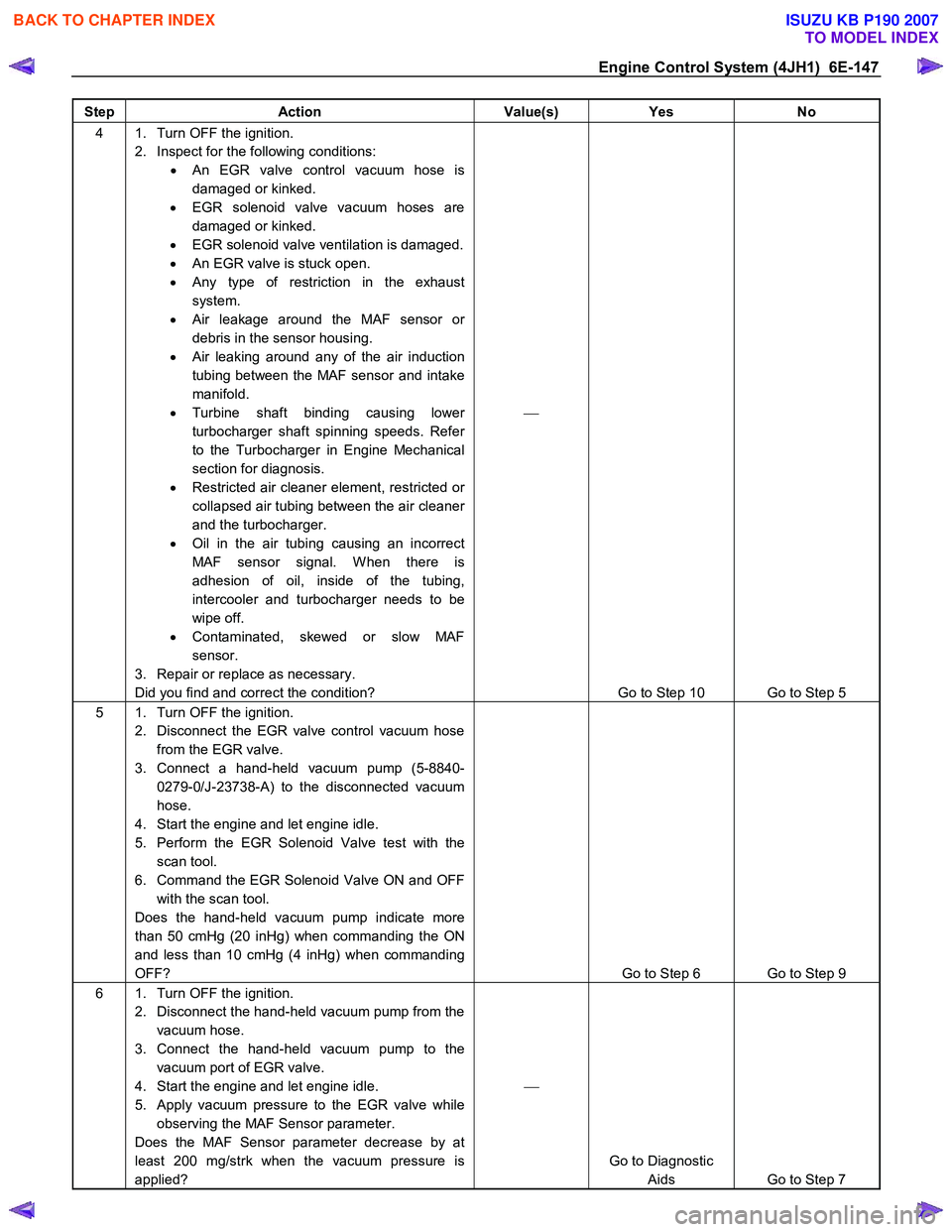
Engine Control System (4JH1) 6E-147
Step Action Value(s) Yes No
4 1. Turn OFF the ignition.
2. Inspect for the following conditions: • An EGR valve control vacuum hose is
damaged or kinked.
• EGR solenoid valve vacuum hoses are
damaged or kinked.
• EGR solenoid valve ventilation is damaged.
• An EGR valve is stuck open.
• Any type of restriction in the exhaust
system.
• Air leakage around the MAF sensor or
debris in the sensor housing.
• Air leaking around any of the air induction
tubing between the MAF sensor and intake
manifold.
• Turbine shaft binding causing lower
turbocharger shaft spinning speeds. Refer
to the Turbocharger in Engine Mechanical
section for diagnosis.
• Restricted air cleaner element, restricted or
collapsed air tubing between the air cleaner
and the turbocharger.
• Oil in the air tubing causing an incorrect
MAF sensor signal. W hen there is
adhesion of oil, inside of the tubing,
intercooler and turbocharger needs to be
wipe off.
• Contaminated, skewed or slow MAF
sensor.
3. Repair or replace as necessary.
Did you find and correct the condition?
Go to Step 10 Go to Step 5
5 1. Turn OFF the ignition. 2. Disconnect the EGR valve control vacuum hose from the EGR valve.
3. Connect a hand-held vacuum pump (5-8840- 0279-0/J-23738-A) to the disconnected vacuum
hose.
4. Start the engine and let engine idle.
5. Perform the EGR Solenoid Valve test with the scan tool.
6. Command the EGR Solenoid Valve ON and OFF with the scan tool.
Does the hand-held vacuum pump indicate more
than 50 cmHg (20 inHg) when commanding the ON
and less than 10 cmHg (4 inHg) when commanding
OFF?
Go to Step 6 Go to Step 9
6 1. Turn OFF the ignition. 2. Disconnect the hand-held vacuum pump from the vacuum hose.
3. Connect the hand-held vacuum pump to the vacuum port of EGR valve.
4. Start the engine and let engine idle.
5. Apply vacuum pressure to the EGR valve while observing the MAF Sensor parameter.
Does the MAF Sensor parameter decrease by at
least 200 mg/strk when the vacuum pressure is
applied?
Go to Diagnostic Aids Go to Step 7
BACK TO CHAPTER INDEX
TO MODEL INDEX
ISUZU KB P190 2007
Page 1182 of 6020
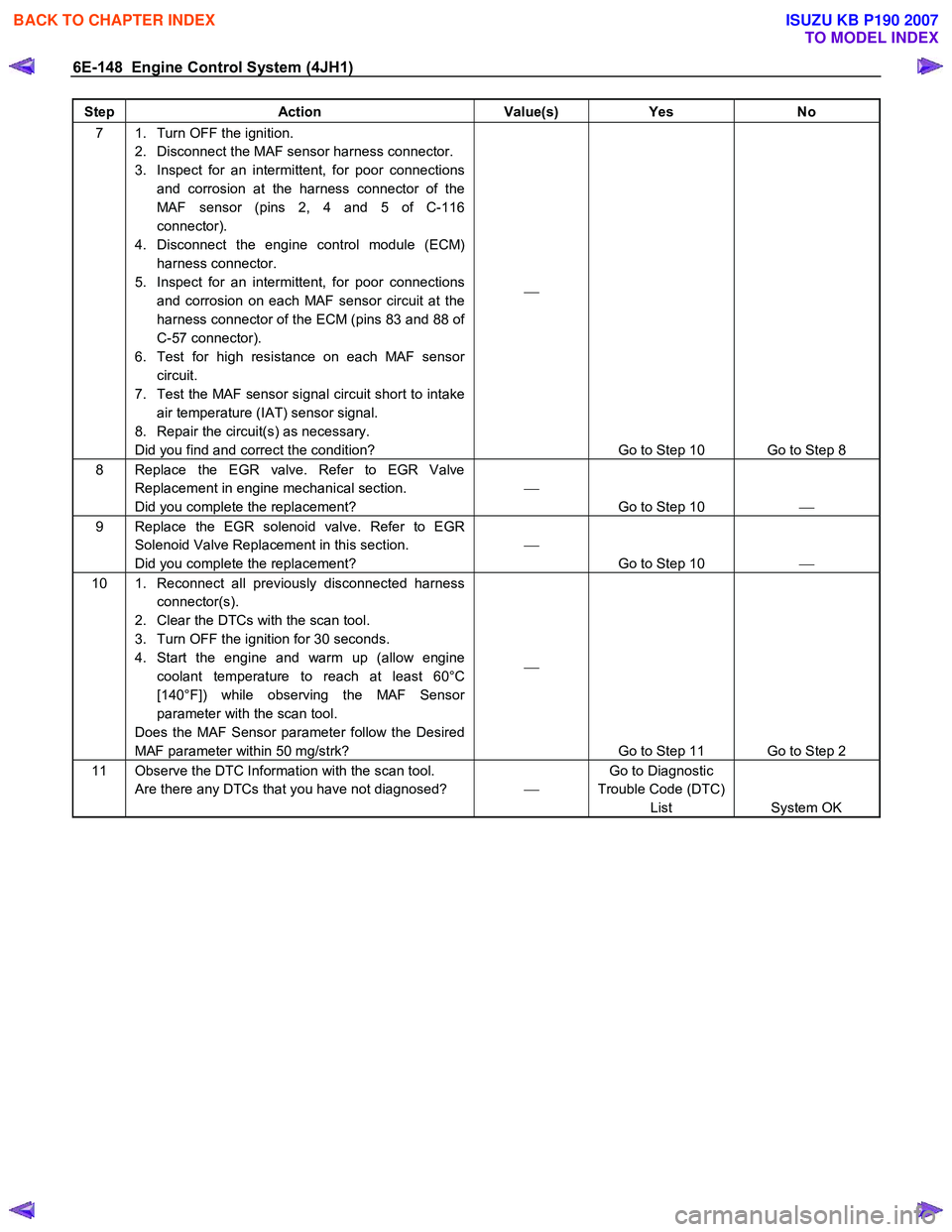
6E-148 Engine Control System (4JH1)
Step Action Value(s) Yes No
7 1. Turn OFF the ignition.
2. Disconnect the MAF sensor harness connector.
3. Inspect for an intermittent, for poor connections and corrosion at the harness connector of the
MAF sensor (pins 2, 4 and 5 of C-116
connector).
4. Disconnect the engine control module (ECM) harness connector.
5. Inspect for an intermittent, for poor connections and corrosion on each MAF sensor circuit at the
harness connector of the ECM (pins 83 and 88 of
C-57 connector).
6. Test for high resistance on each MAF sensor circuit.
7. Test the MAF sensor signal circuit short to intake air temperature (IAT) sensor signal.
8. Repair the circuit(s) as necessary.
Did you find and correct the condition?
Go to Step 10 Go to Step 8
8 Replace the EGR valve. Refer to EGR Valve Replacement in engine mechanical section.
Did you complete the replacement?
Go to Step 10
9 Replace the EGR solenoid valve. Refer to EGR
Solenoid Valve Replacement in this section.
Did you complete the replacement?
Go to Step 10
10 1. Reconnect all previously disconnected harness
connector(s).
2. Clear the DTCs with the scan tool.
3. Turn OFF the ignition for 30 seconds.
4. Start the engine and warm up (allow engine coolant temperature to reach at least 60°C
[140°F]) while observing the MAF Sensor
parameter with the scan tool.
Does the MAF Sensor parameter follow the Desired
MAF parameter within 50 mg/strk?
Go to Step 11 Go to Step 2
11 Observe the DTC Information with the scan tool. Are there any DTCs that you have not diagnosed? Go to Diagnostic
Trouble Code (DTC) List System OK
BACK TO CHAPTER INDEX
TO MODEL INDEX
ISUZU KB P190 2007
Page 1183 of 6020
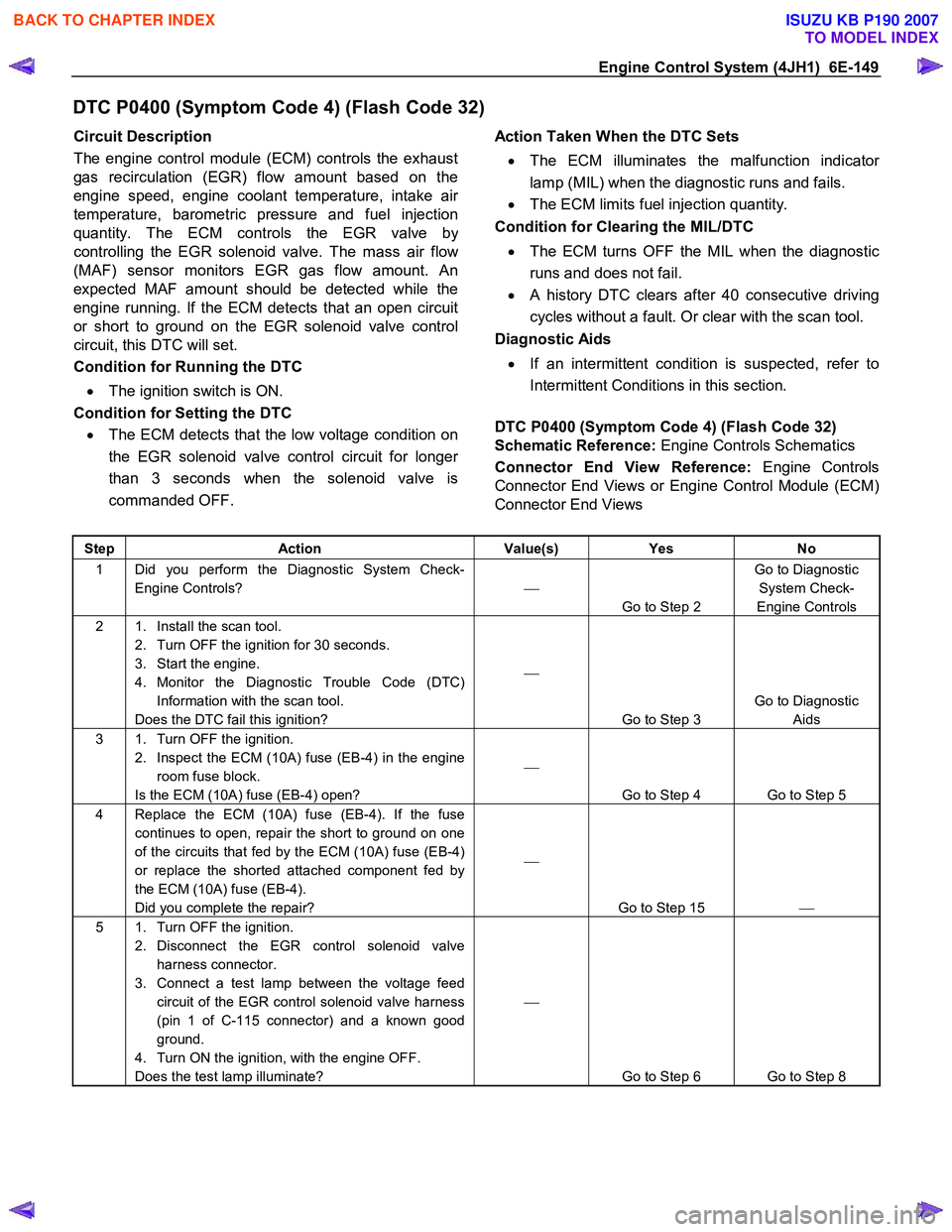
Engine Control System (4JH1) 6E-149
DTC P0400 (Symptom Code 4) (Flash Code 32)
Circuit Description
The engine control module (ECM) controls the exhaust
gas recirculation (EGR) flow amount based on the
engine speed, engine coolant temperature, intake ai
r
temperature, barometric pressure and fuel injection
quantity. The ECM controls the EGR valve b
y
controlling the EGR solenoid valve. The mass air flo
w
(MAF) sensor monitors EGR gas flow amount. An
expected MAF amount should be detected while the
engine running. If the ECM detects that an open circuit
or short to ground on the EGR solenoid valve control
circuit, this DTC will set.
Condition for Running the DTC
• The ignition switch is ON.
Condition for Setting the DTC • The ECM detects that the low voltage condition on
the EGR solenoid valve control circuit for longe
r
than 3 seconds when the solenoid valve is
commanded OFF.
Action Taken When the DTC Sets
• The ECM illuminates the malfunction indicato
r
lamp (MIL) when the diagnostic runs and fails.
• The ECM limits fuel injection quantity.
Condition for Clearing the MIL/DTC
• The ECM turns OFF the MIL when the diagnostic
runs and does not fail.
• A history DTC clears after 40 consecutive driving
cycles without a fault. Or clear with the scan tool.
Diagnostic Aids
• If an intermittent condition is suspected, refer to
Intermittent Conditions in this section.
DTC P0400 (Symptom Code 4) (Flash Code 32)
Schematic Reference: Engine Controls Schematics
Connector End View Reference: Engine Controls
Connector End Views or Engine Control Module (ECM)
Connector End Views
Step Action Value(s) Yes No
1 Did you perform the Diagnostic System Check-
Engine Controls?
Go to Step 2 Go to Diagnostic
System Check-
Engine Controls
2 1. Install the scan tool. 2. Turn OFF the ignition for 30 seconds.
3. Start the engine.
4. Monitor the Diagnostic Trouble Code (DTC) Information with the scan tool.
Does the DTC fail this ignition?
Go to Step 3 Go to Diagnostic
Aids
3 1. Turn OFF the ignition. 2. Inspect the ECM (10A) fuse (EB-4) in the engine room fuse block.
Is the ECM (10A) fuse (EB-4) open?
Go to Step 4 Go to Step 5
4 Replace the ECM (10A) fuse (EB-4). If the fuse continues to open, repair the short to ground on one
of the circuits that fed by the ECM (10A) fuse (EB-4)
or replace the shorted attached component fed by
the ECM (10A) fuse (EB-4).
Did you complete the repair?
Go to Step 15
5 1. Turn OFF the ignition.
2. Disconnect the EGR control solenoid valve harness connector.
3. Connect a test lamp between the voltage feed circuit of the EGR control solenoid valve harness
(pin 1 of C-115 connector) and a known good
ground.
4. Turn ON the ignition, with the engine OFF.
Does the test lamp illuminate?
Go to Step 6 Go to Step 8
BACK TO CHAPTER INDEX
TO MODEL INDEX
ISUZU KB P190 2007